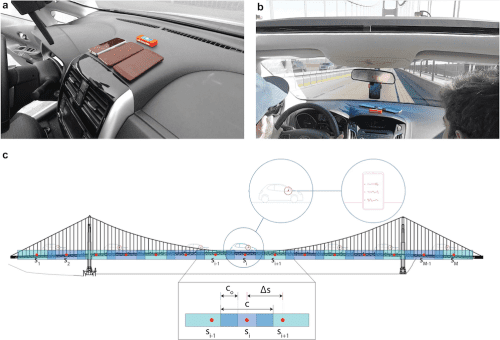Earlier this year a 50-year-old bridge collapsed in Pittsburgh, sending a municipal bus with people onboard plummeting along with the span of the bridge. Rescuers rappelled down a ravine, forming a human chain to reach the victims trapped under the collapsed bridge. Miraculously there were no fatalities, although four people required hospital care.
This unfortunate event served as a wake-up call that the nation needs urgent infrastructure investment. In fact, the bridge collapse occurred just hours before President Biden arrived in the city of Pittsburgh to promote his $1 trillion infrastructure bill.
Revamping the nation’s infrastructure, which includes over 600,000 bridges, will take a lot of time regardless of how much money you throw at the problem, but according to a new study, anyone could pitch in using their smartphone data to keep people safe from crumbling infrastructure.
Is this bridge safe to cross? There’s an app for that
Researchers at MIT and the U.S. Military Academy at West Point in New York drove over the iconic Golden Gate Bridge in San Francisco over 100 times and also collected data from 72 Uber trips over the suspension bridge. They also collected data from 280 passes over a 30-meter-long concrete bridge in the town of Ciampino, Italy, which is more representative of the kind of bridge most people have to cross.
Infrastructure inspectors typically place sensors on bridges they need to monitor that constantly measure key parameters such as strain, displacement, force, temperature, inclination, and alignment. This data helps engineers detect cracks, corrosion, and faults before they lead to a larger issue.
But your smartphone is already packed with similar sensors, particularly accelerometers and GPS sensors. The researchers found that during a single pass, a person’s phone can collect as much information about the structural integrity of a bridge as hundreds of stationary sensors. For both bridges, the phone’s sensors detected vibrations in the structure that were within a few percent of the recordings performed by dedicated infrastructure sensors. The data was gathered using an Android-based app developed by the team and was subsequently cleaned up to remove noise from engines and traffic, isolating the modal vibration frequencies of the bridge itself.

“These results suggest that massive and inexpensive datasets collected by smartphones could play an important role in monitoring the health of existing transportation infrastructure,” the authors write in their new paper.
Because a phone records data continuously over the entire stretch of the bridge as it travels down it, engineers can monitor a bridge’s health more reliably than data from sensors placed in specific locations along a bridge that might miss a weak spot.
Virtually everyone has a smartphone equipped for this job, which is why the researchers hope to get transportation companies, government agencies, and the public onboard to share their smartphone data recorded while crossing critical national infrastructure. Placing sensors and monitoring the data can be excruciatingly expensive and demand a lot of manhours — precious resources that could be diverted elsewhere where they are most needed.
That’s not to say that dedicated bridge sensors will be replaced anytime soon, but you can’t beat smartphone sensors in terms of scale and convenience. The two can co-exist providing much-needed safety data so local authorities can act in time.
“We still have work to do, but we believe that our approach could be scaled up easily – all the way to the level of an entire country,” Carlo Ratti, Director of the MIT Senseable City Laboratory and co-author of the new study, said in a statement.
“It might not reach the accuracy that one can get using fixed sensors installed on a bridge, but it could become a very interesting early-warning system. Small anomalies could then suggest when to carry out further analyses.”
The findings appeared in the journal Communications Engineering.






